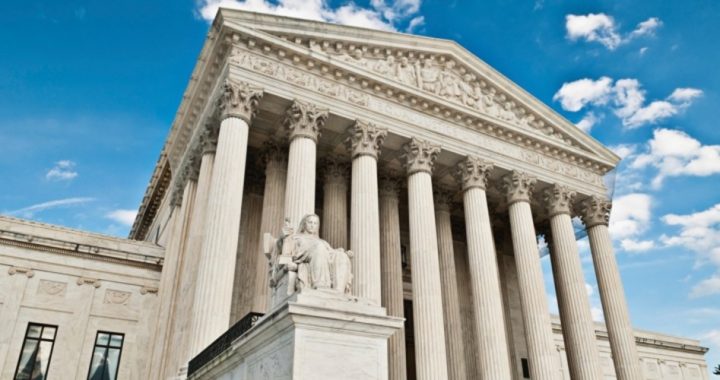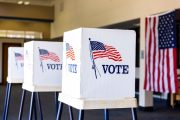
In a stunning victory for President Trump, the Constitution of the United States, and for the American people, the U.S. Supreme Court upheld Trump’s “travel ban” in a decision announced Tuesday. The “travel ban,” issued in an executive order last September by Trump in accordance with his authority under existing federal law and his executive authority as president, to temporarily restrict entry into the United States from seven countries, was ruled legal with the decision.
The decision was 5-4 along predictable lines: Chief Justice John Roberts, associate justices Anthony Kennedy, Clarence Thomas, Samuel Alito, and Neal Gorsuch voted to uphold the ban; while four associate justices, all appointed by Democratic presidents — Sonia Sotomayor, Elena Kagan, Stephen Breyer, and Ruth Bader Ginsburg — voted to overturn Trump’s ban.
Trump tweeted a response of, “Supreme Court Upholds Trump Travel Ban. Wow!” then went on to say, “This ruling is also a moment of profound vindication following months of hysterical commentary from the media and Democratic politicians who refuse to do what it takes to secure our border and our country.”
Chief Justice Roberts wrote the majority opinion, stating, “The Proclamation is squarely within the scope of Presidential authority.”
Roberts’ opinion was blunt: “Plaintiffs argue that this President’s words strike at fundamental standards of respect and tolerance, in violation of our constitutional tradition.” Opponents of Trump’s travel ban argued that the ban on those entering the United States from seven countries, including Iran, Syria, Libya, Yemen, Somalia, North Korea, and Venezuela, targeted Muslim-majority countries. They cited Trump’s campaign statements, in which he called for a ban on travel from all Muslim-majority countries, but two countries with few Muslims — North Korea and Venezuela — were also on the “travel ban” list.
Roberts dismissed the arguments that Trump’s campaign rhetoric should be considered by the Court as discriminatory, and that this was a reason to strike down the “travel ban.” “But the issue before us is not whether to denounce the statements,” Roberts wrote. “It is instead the significance of those statements in reviewing in a Presidential directive, neutral on its face, addressing a matter within the core of executive responsibility. In doing so, we must consider not only the statements of a particular President, but also the authority of the Presidency itself.”
In other words, Trump’s personal views are irrelevant — only the president’s constitutional authority and the words actually found in the executive order matter.
Opponents of the decision of the Court included “the usual suspects.” The state of Hawaii had challenged the executive order, and their lawyers argued that the “travel ban” went beyond Trump’s authority under immigration law, as well as under the Constitution. Neal Katyl, a lead attorney for Hawaii in the case, said, “While we continue to believe that this third version [of the Travel Ban] fails that test [of constitutionality], there is no question that by striking down the first two travel bans, the judiciary forced a recalcitrant administration to at least give its order the veil of constitutionality.”
Katyl said he was “disappointed” in the decision, and he was asking Congress to reverse the ban. Good luck with that, one might respond, considering two things. One, President Trump’s executive order was in accordance with an existing law passed by Congress. Two, were opponents of the ban able to actually get the votes to change that law, it would almost certainly be vetoed by this president. And, even if the travel ban opponents were able to muster a majority in both the House and the Senate, no one seriously believes they could obtain the two-thirds majority in both houses to override that certain Trump veto.
Not surprisingly, the American Civil Liberties Union (ACLU) denounced the decision in a tweet: “This is not the first time the Court has been wrong, or has allowed official racism and xenophobia to continue rather than standing up to it.” Omar Jadwat, who is the director of the Immigrants’ Rights Project of the ACLU, predicted the “ruling will go down in history as one of the Supreme Court’s great failures.”
The chairman of the Democratic National Committee, Tom Perez, was incensed. “Discrimination is not a national security strategy, and prejudice is not patriotism. Let’s call this ban for what it is: an outright attack on the Muslim community that violates our nation’s commitment to liberty and justice for all.”
Representative Keith Ellison (D-Minn.), the first Muslim ever elected to Congress, predictably disagreed with the decision, arguing that it gives “legitimacy to discrimination and Islamophobia.”
Justice Sotomayor dissented strongly. “The majority here completely sets aside the President’s charged statements about Muslims as irrelevant. That holding erodes the foundational principles of religious tolerance that the court elsewhere has so emphatically protected, and it tells members of minority religions in our country ‘that they are outsiders, not full members of the political community.’”
Sotomayor even compared the opinion with the World War II Koramatsu v. United States ruling of the Supreme Court, which upheld President Franklin Roosevelt’s infamous executive order that had thousands of American citizens of Japanese ancestry interned. Roberts felt compelled to repudiate Sotomayor’s comparison, arguing that the Court had erred in 1944.
But it does illustrate the irrational comparisons often made by the Left. President Roosevelt’s granddaughter, for example, even went so far Monday as to say that Trump’s border policies (which have led to the alleged children of some illegal aliens being separated from them) are “worse” than the internment of 120,000 legal residents of the United States, 80,000 of which were American citizens, simply because they were of Japanese ancestry.
Sotomayor’s remarks also illustrate the lasting legacy of the man who nominated her to the Court — President Barack Obama — who vowed to “fundamentally transform America,” and it illustrates how important the 2016 presidential election that kept Hillary Clinton from taking his place — and making judicial appointments — really was.



